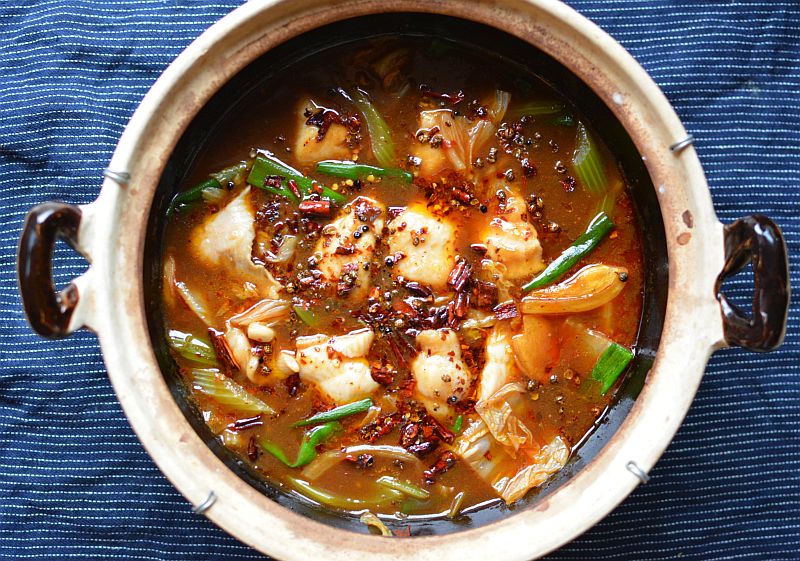
The first time I ordered boiling fish at a restaurant I expected some sort of spectacle -- maybe a bubbling pot delivered to the table. Nope, what I got was a large bowl filled with just cooked greens and delicately cooked fish filet pieces in lots of salty-spicy-funky gravy topped with loads of chile and nubbins of Sichuan peppercorn. It was mala -- the Chinese term to describe numbing, tingly hot deliciousness. I was smitten with boiling fish at first site and first bite.
When I went to look up the dish in Fuchsia Dunlop’s Sichuan cookbook, I realized that many things may be made in this boiling style -- beef and eel, for example. The vegetables may vary but you want them to contrast with the protein, which is quickly simmered/boiled so as to preserve a delicate texture. Boiling fish (水煮鱼, shui yu yu) is a superb dish because of all the intriguing flavors and textural contrasts. There’s a ton of umami, too.
The other thing with these ‘boiled’ dishes is this: they tend to be very oily. It’s a Sichuan thing. Traditional mapo tofu has a slick of oil on top. When I had mapo in Chengdu, the layer of oil was a good ⅛ inch thick. The heaviness of the dish sort of matches Sichuan’s climate, which can be foggy and humid. The oil used when I was in China was a semi-refined canola oil that was yellow and thick like corn oil.
A lighter route to Sichuan Boiling Fish
If I was to include boiling fish in my repertoire, I needed to cut back on the oil. For traditional boiling fish, you heat about ¼ cup of oil until smoking then and pour it over the cooked dish to aromatize the chile and peppercorns and add extra richness.
I substituted about 1 tablespoon of homemade chile oil to cut back on the oil and drama. The chile-flavored oil still lent punch, which is the point of searing the spices at the end. You’re welcome to do the sizzling oil to stay true to Sichuan cuisine!
This a boiling fish recipe that I’ve been working on for a while and it’s finally ready for you to try. The hardest thing will be to get the Sichuan chile bean paste -- pixian dou ban jiang. The good stuff is at Chinese markets. If you get a pound, you’ll have it for years to make dishes like this and mapo tofu and many many more, awesome Chinese preparations. More on the fermented bean and chile paste is in this post.
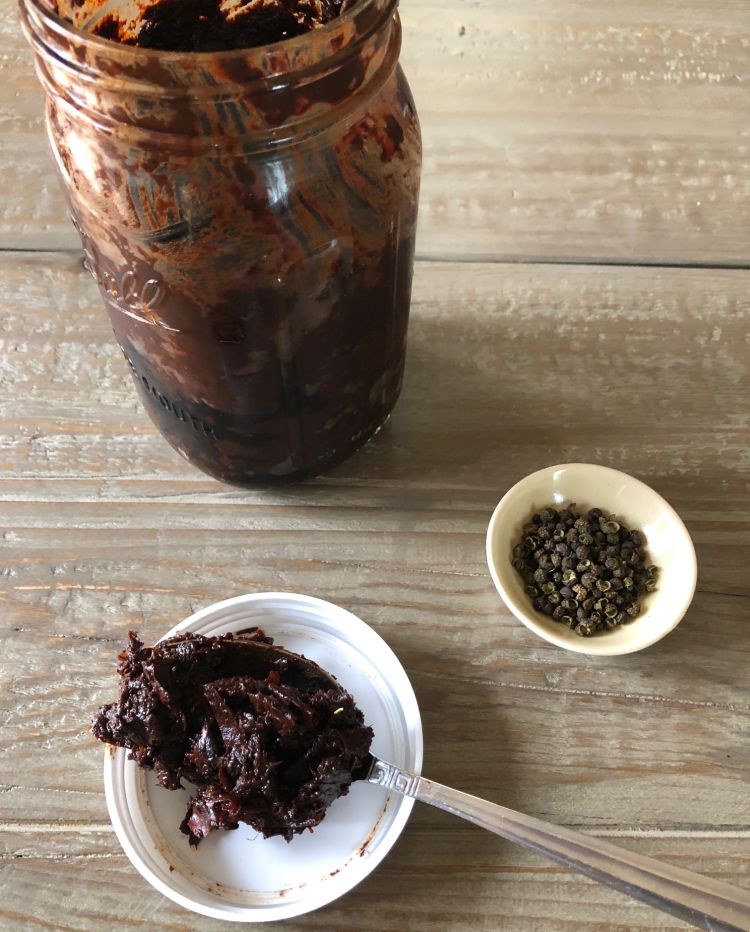
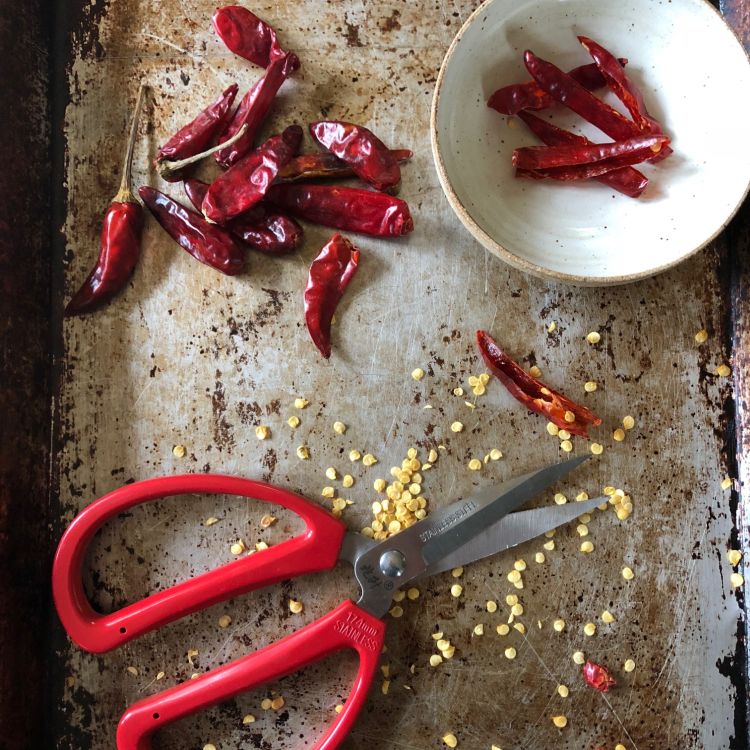
Additionally, you need Sichuan peppercorn and dried chiles, which together with the bean paste is a trio of ingredients commonly found in fiery dishes of the region. They're not hard to find at regular markets these days.
What kind of fish to use? I chose catfish and petrale sole filet because they’d cook up on the firm side and had good flavor to stand up to the bean paste. No wimpy fish for this dish. You could use fish steaks, I suppose.
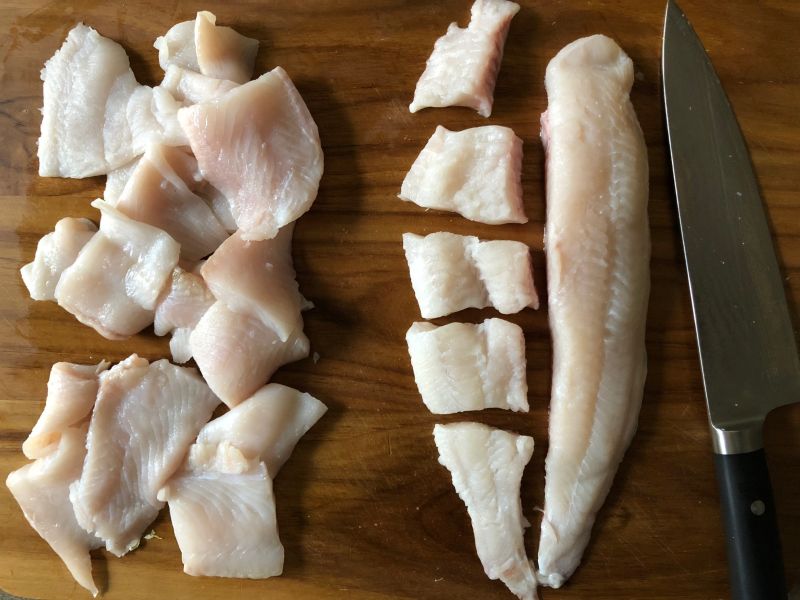
The beauty of boiling fish is you can load it up with vegetables. It’s an intense one-dish meal. Maybe add a little cool cucumber salad on the side? Celery and napa cabbage are my choice. You could use soybean sprouts which tend to be a little crunchier than mung bean sprouts. Wood ear and/or shiitake would be good, too. Think of contrasting textures and refreshing flavors.
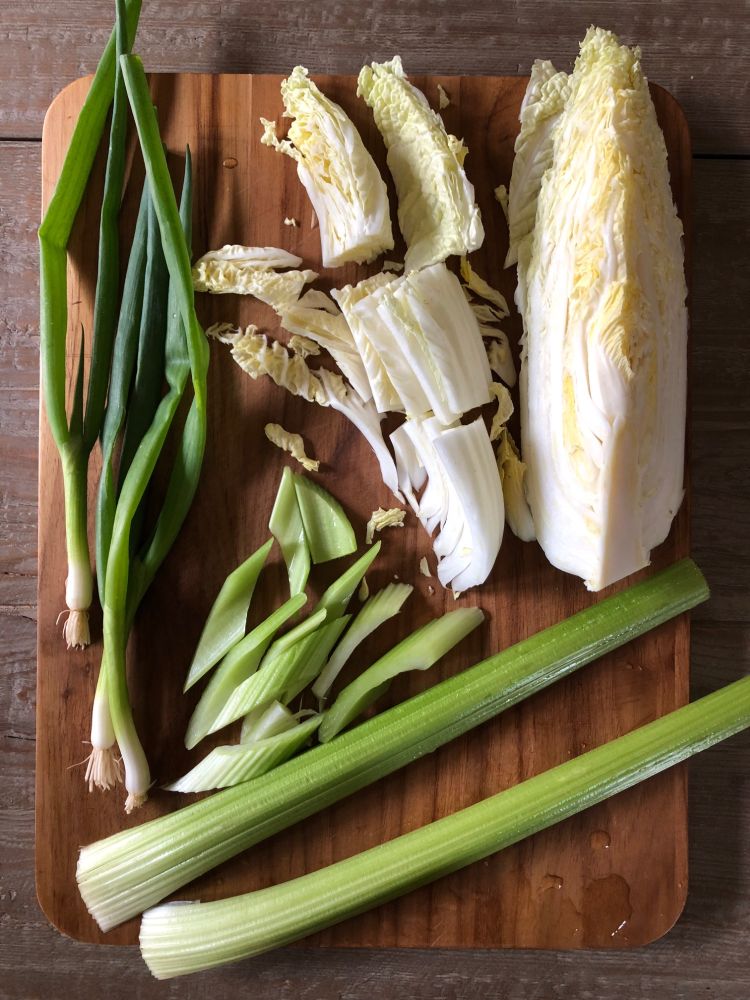
Then, I cooked everything in a big clay pot, in order to go from stovetop to table. All you have to do is heat the clay pot slowly with some oil and it will be a terrific vessel for frying the chiles and later stir-frying the green onion, ginger and bean paste.
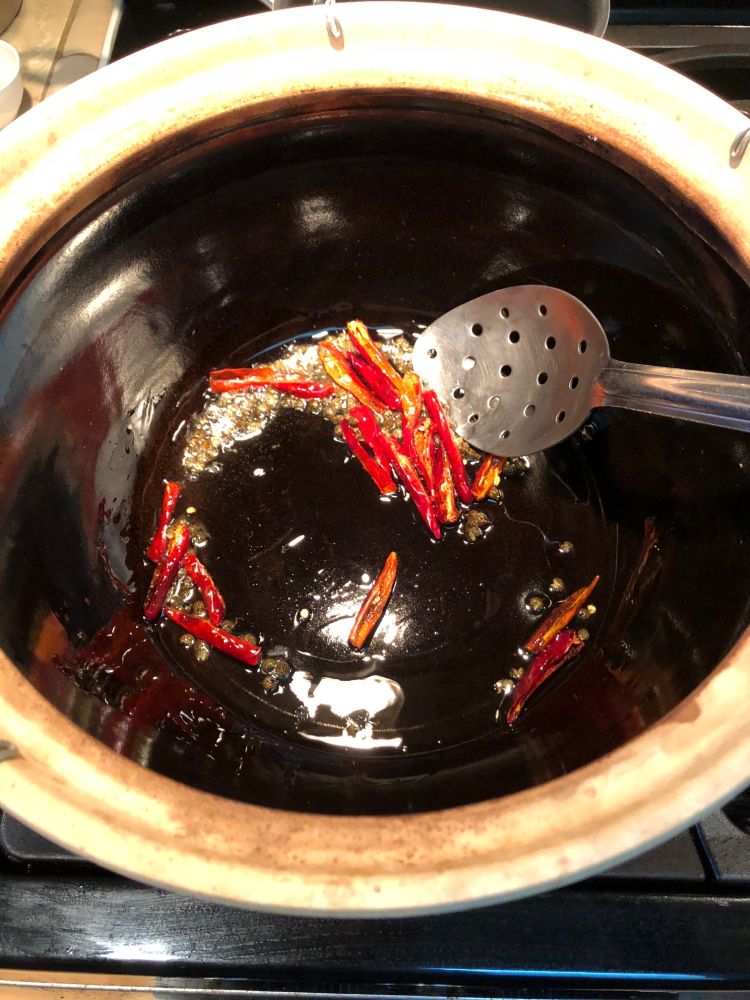
Clay pots (a.k.a., “sandy pots") can also cook beautifully at low heat. I’ve cooked rice, simmered stews, and baked beans in this vessel, which I’ve owned for about 12 years. You can buy it for very little money from Chinese housewares shops like the Wok Shop. Or, get fancy with a Japanese donabe. A heavy enamel coated cast-iron Dutch oven like this would work, as well.
It’s still cold in many parts of the country so it’s perfect boiling fish weather.
Boiling Fish (Shui Zhu Yu)
Yield 4 servings
If you want a touch of pungency in your boiling fish, add 2 or 3 sliced garlic cloves along with the green onion and ginger. There's a lot of leeway in this Sichuan classic. And it comes together fairly fast.
Ingredients
- 1 to 1 ¼ pounds firm white fish filet, such as catfish or petrale sole, cut into 2-inch pieces
- ½ teaspoon fine sea salt
- 2 teaspoons Shaoxing rice wine or dry sherry
- About ¼ cup neutral oil, such as canola
- 6 to 8 dried chiles de Arbol or other slender moderately hot chiles, halved lengthwise with scissors and seeded
- 2 teaspoons red or green Sichuan peppercorns
- 4 ribs celery (6 ounces), cut on a steep diagonal into ½-wide pieces
- 12 ounces napa cabbage, cut into 2-inch pieces
- 3 green onions, cut into 3-inch lengths, whites separated from greens
- 2 slices ginger, unpeeled, bruised
- 2 ½ to 3 tablespoons Sichuan fermented chile bean sauce (dou ban jiang)
- 3 cups lightly salted chicken stock, or 1 (14.5-ounce) can chicken broth plus 1 ⅓ cups water
- ¼ cup potato starch or cornstarch combined with ¼ cup water
- 2 teaspoons soy sauce, as needed
- About 1 tablespoon Homemade Chile Oil (the regular kind is just fine)
Instructions
- In a bowl, combine the fish with ¼ teaspoon salt and the wine (or sherry). Set aside.
- Set a large (4 or 5-quart) clay pot, donabe, or similar kind of heavy pot over medium heat with 2 tablespoons oil. When shimmering, add the chiles and peppercorns. Stir and let fry for about 45 seconds, then use a slotted spoon to scoop into a bowl, leaving oil behind. Set aside to cool.
- Reheat the pot over medium-high heat. Add the celery and cabbage and ¼ teaspoon salt. Cook for 1 minute, until crisp-tender. Hold in a bowl.
- Return the pot to the burner. Still over medium-high heat (or increase the heat to high, if you want more heat) and add 1 to 2 tablespoons oil to the pot. When shimmering, add the green onion whites, ginger, and bean paste. Stir to loosen up and when aromatic, add the stock (plus water, if using). Let come to a boil.
- Meanwhile, add the starch slurry to the fish. And, roughly chop the cooled fried chile and peppercorn mixture. Keep near the stove.
- When the pot comes to a boil, add the fish and all the starchy liquid. As the fish cooks and firms up, 1 to 2 minutes, gently nudge with chopsticks to keep the piece separate. Taste and if needed, add the soy sauce for salty, savory depth.
- Throw in the remaining green onion parts and let cook for 15 to 30 seconds to soften and meld flavors. Turn off the heat. Sprinkle the chopped chile and peppercorns on top, then finish with the chile oil. Bring to the table and serve.
Courses dinner
Cuisine Chinese













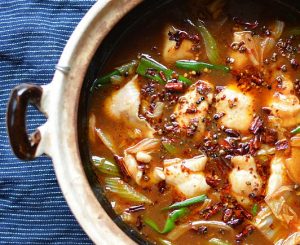




Vickie says
When I married my now late husband from Taiwan I did not know his family came from Chengdu, China. It a county of
SzeChuan. No wonder my three children love hot spicy food it from my husband side for my side is Cantonese no spicy at all.
Andrea Nguyen says
But then you met in Taiwan so the mild flavors of Guangzhou melted with the fiery flavors of Sichuan! Love it. Thanks, Vickie!
Lajoieduchant says
I have never had this soup, yet, after seeing the picture; I am dreaming about it! I cannot WAIT to taste this! You know, I don't think I have ever had any type of fish soup..... ever. I have had Maryland Crab soup before, but not fish. ...and if you ever try Maryland Crab soup, refuse to eat it if it has the hair like whisps of fibers in it. That is an abomination. You should be getting a savory, spicy tomato based vegetable laden soup with pearly white hunks of jumbo lump or backfin the size of the first segment of your thumb. The vegetables in it are common, onions, garlic, celery, carrots, potatoes, okra, green beans, tomatoes, etc. Sometimes, things like lima beans, too. That is often the only difference in the soups, unless you are unfortunate enough to have someone try to feed you crab scraps. In Maryland? Just say no! There is enough crab here to make that soup wow a person. The blue crabs here are sweet and can stand up to a ton of Old Bay or a custom crab spice mix. Just hope the chef makes sure not to kill you with sodium. That's the other thing to look out for.
...but this fish soup, I must make and taste. Wow.
Andrea Nguyen says
Yowza, it's a keeper in your kitchen! Thanks for making the recipe and taking time to write!!!!
Kimberly says
So many wonderful flavors going on in here!
James in Oamaru says
What do you mean by a half inch of salt?
Andrea Nguyen says
What typo. That's 1/2 teaspoon of salt. Thanks for pointing it out.
Tiffany Cheng says
Interesting recipe
I have to explain to you the reason why Sichuan food is oily and spicy. Sichuan food is oily and spicy because Sichuan is a cold and humid place with frequent overcast and little sunshine exposure. So, in order to survive Sichuan’s cold and humid climate alongside with the frequent overcast and little sunshine exposure, the Chinese from Sichuan need to eat oily and spicy food. If they don’t eat oily and spicy food they would get sick easily due to the cold temperature or easily get arthritis due to the extreme humidity of Sichuan.
Andrea Nguyen says
Yes -- I noticed the damp fog when I visited Chengdu and we drove out of town to check out a pixian doubanjiang maker. It's unusual but no one explained the rich foods of the region in terms of traditional Chinese medicine. Thank you!